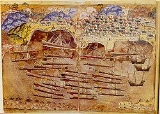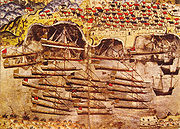
Matrakçi Nasuh
Encyclopedia

Matrak
Matrak is a Turkish game invented by Matrakçı Nasuh in 16th century. It is played by wooden sticks which are covered with leather and look like bowling ten-pins. The tops of the sticks are rounded and slightly wider than the body. The game is a kind of battle animation and it is a lawn game...
(also known as Nasuh el-Silâhî - Nasuh the Swordsman - because of his talent with weapons) was a 16th century Ottoman
Ottoman Empire
The Ottoman EmpireIt was usually referred to as the "Ottoman Empire", the "Turkish Empire", the "Ottoman Caliphate" or more commonly "Turkey" by its contemporaries...
mathematician
Mathematician
A mathematician is a person whose primary area of study is the field of mathematics. Mathematicians are concerned with quantity, structure, space, and change....
, teacher
Teacher
A teacher or schoolteacher is a person who provides education for pupils and students . The role of teacher is often formal and ongoing, carried out at a school or other place of formal education. In many countries, a person who wishes to become a teacher must first obtain specified professional...
, historian
Historian
A historian is a person who studies and writes about the past and is regarded as an authority on it. Historians are concerned with the continuous, methodical narrative and research of past events as relating to the human race; as well as the study of all history in time. If the individual is...
, geographer
Geographer
A geographer is a scholar whose area of study is geography, the study of Earth's natural environment and human society.Although geographers are historically known as people who make maps, map making is actually the field of study of cartography, a subset of geography...
, cartographer, swordmaster
Swordmaster
Swordmaster or Sword Master may refer to:* Kensei - an adept in swordsmanship* Swordmaster, one of several characters from the Soul Calibur video game series* Swordmaster, a unit classes in Fire Emblem video games...
, and miniaturist of Bosniak origin. He was brought to Istanbul after being recruited by the Ottoman scouts in Rumalia, educated, served several Ottoman Sultans and became a teacher at Enderun School
Enderun School
Enderun School which meant "inner most" was a free-boarding school for the Christian Millet of the Ottoman Empire, which recruited students via Devshirme - an enculturation system of the Christian youngsters for learning the characteristics of the Islamic society and the unique culture of the...
.
Life
Matrakçı Nasuh, was a gifted JanissaryJanissary
The Janissaries were infantry units that formed the Ottoman sultan's household troops and bodyguards...
of Bosnia who went through both the Infantry and devşirme system, a gifted swordsman and sharp shooter well known for his intellect; he spoke 5 languages and was recruited into the Ottoman Navy
Ottoman Navy
The Ottoman Navy was established in the early 14th century. During its long existence it was involved in many conflicts; refer to list of Ottoman sieges and landings and list of Admirals in the Ottoman Empire for a brief chronology.- Pre-Ottoman:...
.
After a long period of studies on mathematics and geometry he wrote his works "Cemâlü'l-Küttâb" and "Kemalü'l- Hisâb" and submitted them to the Ottoman Sultan Selim I
Selim I
Selim I, Yavuz Sultân Selim Khan, Hâdim-ül Haramain-ish Sharifain , nicknamed Yavuz "the Stern" or "the Steadfast", but often rendered in English as "the Grim" , was the Sultan of the Ottoman Empire from 1512 to...
. He wrote also the two books named "Mecmaü't-Tevârih" and "Süleymannâme". They deal about the history of the period 1520 - 1543. He also wrote a historical piece on the Iran
Iran
Iran , officially the Islamic Republic of Iran , is a country in Southern and Western Asia. The name "Iran" has been in use natively since the Sassanian era and came into use internationally in 1935, before which the country was known to the Western world as Persia...
campaign of Suleiman I titled "Fetihname-i Karabuğdan".
A recent study of his book, Umdet-ul Hisab revealed an unknown fact that Matraki had invented some genuine multiplication methods. One of the significant results displayed in this book was that the lattice method had been widely used in the Enderun nearly 50 years before John Napier
John Napier
John Napier of Merchiston – also signed as Neper, Nepair – named Marvellous Merchiston, was a Scottish mathematician, physicist, astronomer & astrologer, and also the 8th Laird of Merchistoun. He was the son of Sir Archibald Napier of Merchiston. John Napier is most renowned as the discoverer...
introduced it to the Western world for the second time after al-Khwārizmī and Fibonacci
Fibonacci
Leonardo Pisano Bigollo also known as Leonardo of Pisa, Leonardo Pisano, Leonardo Bonacci, Leonardo Fibonacci, or, most commonly, simply Fibonacci, was an Italian mathematician, considered by some "the most talented western mathematician of the Middle Ages."Fibonacci is best known to the modern...
. Besides his works on mathematics and history he is very famous because of his miniatures
Ottoman miniature
Ottoman Miniature or Turkish miniature was an art form in the Ottoman Empire, which can be linked to the Persian miniature tradition, as well as strong Chinese artistic influences. It was a part of the Ottoman Book Arts together with illumination , calligraphy , marbling paper and bookbinding...
. He created a naturalist style which focuses on panoramic views of landscapes and cities painted with the greatest detail (his most famous work, the Istanbul landscape picture, shows almost every street and building of the city). In Ottoman miniature art this was later known as "Matrakçı style". The most important of his four historic volumes of miniatures is that dealing with Suleiman I’s first Iran-Iraq campaign in 1534-35. Besides illustrating the march of the Ottoman army from Istanbul
Istanbul
Istanbul , historically known as Byzantium and Constantinople , is the largest city of Turkey. Istanbul metropolitan province had 13.26 million people living in it as of December, 2010, which is 18% of Turkey's population and the 3rd largest metropolitan area in Europe after London and...
to Baghdad
Baghdad
Baghdad is the capital of Iraq, as well as the coterminous Baghdad Governorate. The population of Baghdad in 2011 is approximately 7,216,040...
and then Tabriz
Tabriz
Tabriz is the fourth largest city and one of the historical capitals of Iran and the capital of East Azerbaijan Province. Situated at an altitude of 1,350 meters at the junction of the Quri River and Aji River, it was the second largest city in Iran until the late 1960s, one of its former...
and its return via Halab
Aleppo
Aleppo is the largest city in Syria and the capital of Aleppo Governorate, the most populous Syrian governorate. With an official population of 2,301,570 , expanding to over 2.5 million in the metropolitan area, it is also one of the largest cities in the Levant...
and Eskisehir
Eskisehir
Eskişehir is a city in northwestern Turkey and the capital of the Eskişehir Province. According to the 2009 census, the population of the city is 631,905. The city is located on the banks of the Porsuk River, 792 m above sea level, where it overlooks the fertile Phrygian Valley. In the nearby...
, he also includes all the cities met by the army along the way. The Library of Istanbul University
Istanbul University
Istanbul University is a Turkish university located in Istanbul. The main campus is adjacent to Beyazıt Square.- Synopsis :A madrasa, a religious school, was established sometime in the 15th century after the Ottoman conquest of Constantinople. An institution of higher education named the...
hosts the only copy of this unique work.
Nasuh was also a soldier and a master Bladesmith
Bladesmith
Bladesmithing is the art of making knives, swords, daggers and other blades using a forge, hammer, anvil, and other smithing tools. Bladesmiths employ a variety of metalworking techniques similar to those used by blacksmiths, as well as woodworking for knife and sword handles, and often...
. He worked as a weapon teacher at Enderun School. He and his students demonstrated their skills in a show which was part of the circumcision
Circumcision
Male circumcision is the surgical removal of some or all of the foreskin from the penis. The word "circumcision" comes from Latin and ....
celebrations of Suleiman I's sons. Because of his success in this demonstration Nasuh received the honorary title of Ustad
Ustad
Ustad is an Arabized Persian word is a honorific title for a Muslim man in South Asia. The title precedes the name and is usually used for well regarded teachers and artists, most often musicians. It is applied and used via informal social agreement. It is abbreviated as ut. or ud.-References:*...
(Master) and Reis
Reis
-Surname:Reis is a common surname in the Portuguese language, namely in Portugal and Brazil. It was originally a Christian devotional family name of the Middle Ages, probably due to the Portuguese name for the Biblical Magi, the Reis Magos . Sometimes the surname is dos Reis...
(Chief) from the Sultan. He also wrote a book about usage of various weapons and techniques of cavalry
Cavalry
Cavalry or horsemen were soldiers or warriors who fought mounted on horseback. Cavalry were historically the third oldest and the most mobile of the combat arms...
and infantry
Infantry
Infantrymen are soldiers who are specifically trained for the role of fighting on foot to engage the enemy face to face and have historically borne the brunt of the casualties of combat in wars. As the oldest branch of combat arms, they are the backbone of armies...
fight, called "Tuhfet-ül Guzât".
Mathematics
- Cemâlü'l-Küttâb
- Kemalü'l- Hisâb
- Umdetü'l-Hisâb
History
- Mecmaü't-Tevârih (Sum of History)
- Süleymannâme (Book of Suleiman)
- Fetihname-i Karabuğdan (Book of Conquest of Black Bogdania)
- Beyan-ı Menazil-i Sefer-ul Irakeyn (Chronicle of Stages of Campaign of Iraq and Persia)

